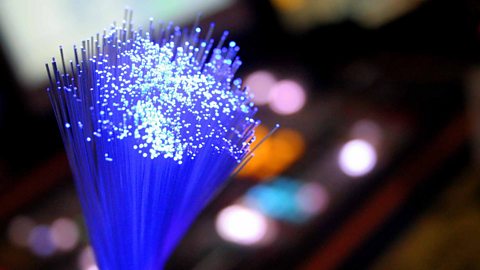Applications of total internal reflection (TIR)
Optical fibres
total internal reflectionWhen the angle of incidence in the dense medium is greater than the critical angle, all the light is reflected and none is refracted. allows light to be contained and guided along very thin fibres.
Usually made of glass, these are called optical fibres and they have many uses:
- fibre broadband internet sends computer information coded as pulses of light along underground optical fibres;
- doctors can look at the inside of their patients using an endoscope - a long tube which guides light into the patient and then guides the reflected light back out to give an image;
- decorations, like some artificial Christmas trees, carry coloured light to different parts of the decoration and let it shine out in different directions.
An optical fibre is a thin fibre of high-quality glass.
Very little light is absorbed by the glass.
Light getting in at one end undergoes repeated total internal reflection and is trapped inside the glass, even when the fibre is bent. It emerges at the other end only slightly less bright.
Information such as computer data, telephone calls and video signals can be converted into either visible light pulses or infrared pulses, and transmitted long distances by optical fibres.
This enables long distance communications to occur quickly and cheaply – a glass fibre is much cheaper than a copper wire needed to carry electrical signals.
In addition, optical fibres can carry much more information than a copper cable of the same diameter.

Endoscopes
Optical fibres are also used in endoscopes that allow surgeons to see inside their patients.
A bundle of optical fibres in a tube guides light into the patient and then guides the reflected light back out to give an image.
A surgeon can see on a monitor what is happening inside a patient’s body, in real time.
Optical fibres make keyhole surgery possible because the endoscope also has instruments for cutting and retrieving tissue.
This means the patient doesn’t have to be cut open which reduces scaring and makes recovery quicker and less painful.